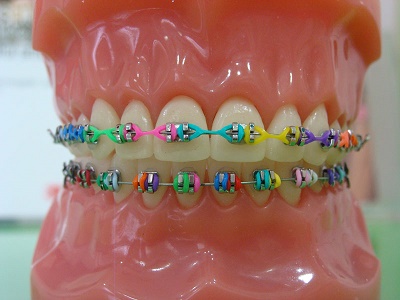Braces
The beauty of the smile is not fully appreciated when your teeth are misaligned or crooked. Orthodontic treatment is used to correct this condition.
Treatment in orthodontics not only means correction of misaligned or crooked teeth but also involves correction of protruding, crowded or irregularly spaced teeth and jaw problems.
Correcting the problem can create a nice looking smile, but more important, orthodontic treatment results in a healthier mouth. That's because crooked and crowded teeth make cleaning the mouth difficult, which can lead to tooth decay, gum disease and possibly tooth loss. An improper bite can interfere with chewing and speaking, can cause abnormal wear to tooth enamel, and can lead to problems with the jaws.
What are Braces made from?
Braces (also called as orthodontic appliances) can be as inconspicuous- or as noticeable - as you like. Brackets - the part of braces that attach to each tooth are smaller and can sometimes be attached to the back of the tooth, making the brackets less noticeable.
Brackets may be made of metal, ceramic, plastic or a combination of these materials. Some brackets are clear or tooth-colored. There are brackets shaped like hearts and footballs, and elastics (Orthodontic rubber bands) in school colors or holiday hues such as red, white and blue. And there are gold-plated braces and glow-in-the-dark retainers.
But if aesthetic is your prime concern then the new form of lingual orthodontics and transparent braces are also your treatment options.
Are they left in the mouth or can they be removed?
There are two types of orthodontic appliances; fixed, which are worn all the time and can only be removed by the dentist, and removable, which the patient ca take out hte mouth. The dentist selects the type based on your needs.

When should treatment begin?
Malocclusions often become noticeable between the ages of 6 and 12 as the child's permanent (adult) teeth erupt. Orthodontic treatment often begins between ages 8 and 14. Treatment that begins while a child is growing helps produce optimal results. As a result, children should have an orthodontic evaluation no later than age 7. By then, they have a mix of primary(baby) teeth and their permanent(adult) teeth. Your child's dentist can spot problems with emerging teeth and jaw growth early on, while the primary teeth are present. That's why regular dental examinations are important.
How about adults wearing Braces?
Children aren't the only ones who can benefit from orthodontics. If you're an adult, it's not too late to correct problems such as crooked or crowded teeth, overbites, under-bites, incorrect jaw position, or jaw-joint disorders. The biological process involved in moving teeth is the same at any age. Usually, adult treatment takes a little longer than a child's treatment. Because an adult's facial bones are no longer growing, certain corrections may not be accomplished with braces alone. No matter your age, it's never too late to improve your dental health and beautify your smile.
Who Provides Orthodontic Treatment?
Most dentists are trained to treat some minor orthodontic problems. If the dentist thinks the patient should see a specialist for treatment, he or she will provide a referral to an orthodontist. Orthodontics is a specialty area of dentistry that is officially known as Orthodontics and Dentofacial Orthopedics. The purpose of orthodontics is to treat malocclusion through braces, corrective procedures and other "appliances" to straighten teeth and correct jaw alignment. An orthodontist is a dentist who specializes in the diagnosis, prevention, and treatment of dental and facial irregularities.
Although treatment plans are customized for each patient, most wear their braces from one to three years, depending on what conditions need correcting. This is followed by a period of wearing a "retainer" that holds teeth in their new positions. Although a little discomfort is expected during treatment, today's braces are more comfortable than ever before. Newer materials apply a constant, gentle force to move teeth and usually require fewer adjustments.
Good oral hygiene is especially important when braces are present. Brushing regularly, as directed by the dentist, flossing daily and scheduling dental visits can help keep teeth healthy.
Patients with braces should maintain a balanced diet and limit between-meal snacks. Your dentist may recommend avoiding certain foods that could interfere with braces or accidentally bend the wires. These foods may include nuts, popcorn, hard candy, ice and sticky foods like chewing gum, caramel or other chewy candy.
Can I play sports while wearing braces?
A protective mouth guard is recommended for sports and other activities that may result in injury to the mouth or jaw. Your dentist can suggest an appropriate mouth guard when the braces are in place. Braces typically do not interfere with playing wind or brass instruments although more practice may be needed to adapt.